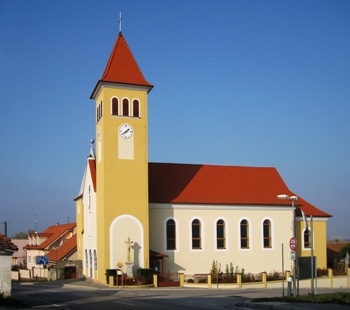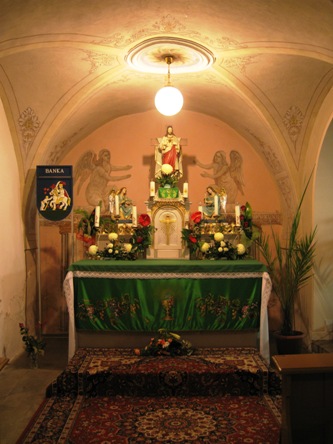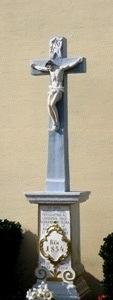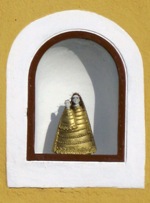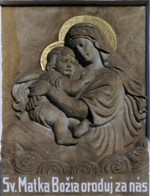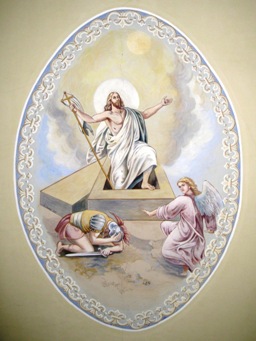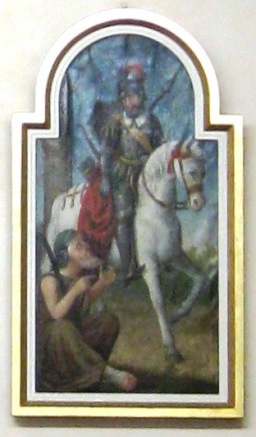 Web Content Display
Web Content Display
St Martin's Church
branch Banka
The first reference to the church of St Martin dates back to the period 1332-1337. In 1599 it was probably burnt down by Crimean Tartars. In the following year the church was repaired and the nave was given a Renaissance vault. The church compound was fortified with a stone wall which was pulled down as late as 1931, in the process of a new church extension. At present, the original Renaissance stone entry portal is built in the new wall in front of the old church facade. Approximately within the period 1581-1647, the church was used by Lutherans. In 1779, a stone cross was raised by the church. A new church from the year 1930 was added to the southern wall of the old church and it is connected to the old one by means of three arches (borne on colulmns). It is actually a semi-detached church then.
From the history of the church
Around 1200, the notary Anonym mentions that in the place of present-day church there was a castle called Bana as far back as in the ninth century. He states that the castle was already there in the period of nomadic Finno-Ugric tribes invading the area of the middle Danube and the territory of Slovakia. Although Anonym's chronicle is not a reliable source of information from historical point of view, it is probably true. Apparently, a brick rotunda or a small church could have been situated here as well. However, these are pure speculations, because up to now neither archeological nor historical research has clarified that.
In the second half of 13th century the castle began to lose its strategic importance, because defense border was altered and other castles were built (Branč, Dobrá Voda, Čachtice and Tematín castle). The castle was referred to as late as 1263.
In the inventory of tithes of papal collectors from the period 1332-1337 there is a reference to St. Martin's Church in Banka district and to the parish priest Benedikt who had paid a tithe of three grosschens to the papal collectors. From that it is possible to deduce that it used to be a small parish with 60 up to 66 inhabitants.
Around 1516 the parish was exempted from the archdeacon's authority and was directly subordinated to the bishop. Another reference to Banka dates back to 1560, when the visitation of parishes within the Estergom archbishopric was carried out, based on the order of the archbishop Mikuláš Oláh residing in Trnava. The Visitor to „Banka", Michal Szegedi found out that the presbytery had been without a parish priest for several years, and at the same time pastoral work had been done by parish priests from the neighborhood.
The likelihood is that when the Váh valley region was devastated by Crimean Tartars in 1599, the church dedicated to St. Martin, situated in Banka, was burnt down, too. Next year the church was repaired and the nave got a Renaissance (cross) vault. The church compound was fortified with a stone wall which was demolished when an extension of a new church was built in 1931.
Nowadays the original Renaissance stone entry portal is built in the new wall in front of the old church facade. Some grave slabs with Latin inscriptions which date back to the years 1616 and 1630 are built in the wall as well. They come from the period when the church was used by Lutherans (in Piešťany whose branch was also Banka later on, the first Lutheran preacher, Ján Vranka was mentioned in 1581. The likelihood is that Lutherans were living in Piešťany still earlier).
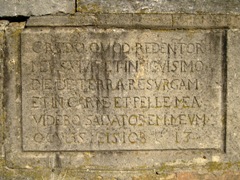 | 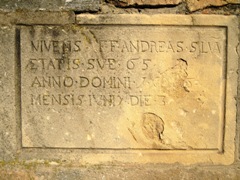 |
A Latin inscription from the year 1637 which is not completely preserved and is built in the wall of the church enclosure is likely to refer to the repair of reconstruction of the church. Its translation is as follows:
„This memorial was entirely completed in 1637, under the Reverend Father Rapko Parlagio, the parish priest, representative of the Slukas' parish church. Under the judges, Mr. Juraj Valachovič and Mr. Štefan Hollý, under the sextons Ján, Fedor and Juraj Kancho".
Some built-in headstones also refer to the Slukas aristocratic family (1707) as well as the inscription on the cross by the church (1779).
Lutherans were definitely divested of the church sometimes following the year 1647.
After establishing the Roman-Catholic parish in Moravany in 1706, Banka together with Ducové and Hubina belonged to the district of the new parish, as its branches.
In documents you can find following priests of Moravany parish who also carried out pastoral work for the believers in Banka:
| 1666 - 1669 | Ján Szervidy | 1764 - 1769 | Matej Kosorinský |
| 1669 - 1671 | Albert Vincenti | 1769 - 1811 | Jozef Lonský |
| 1706 - 1709 | František Dávid | 1823 - 1840 | Jozef Vendelín Bošány |
| 1709 - 1716 | Michal Blaškovič | 1840 - 1859 | Jozef Duchon |
| 1716 - 1720 | Mikuláš Nečislavský | 1859 - 1873 | Florián Némethy |
| 1720 - 1721 | Anton Vajdovič | 1873 - 1891 | Ján Bapt. Dubnický |
| 1721 - 1723 | Peter Zbornický | 1892 - 1900 | Rudolf Molnár |
| 1723 - 1728 | Štefan Raukay | 1901 - 1904 | Ján Lukáč |
| 1728 - 1748 | Jakub Peserín | 1904 - 1905 | František Vozár |
| 1748 - 1760 | Jozef Krásneč | 1905 | František Jehlička |
| 1750 - 1751 | Matej Derer | 1905 - 1932 | František Novák |
| 1751 - 1764 | Andrej Jantulík |
|
|
Parish registers from the whole parish district (births, marriages, deaths) had been preserved. Since 1895 state registers have been kept.
In 1779, a stone cross was built by the church. It was donated by a squire, Alexander Sluka. The cross was renovated in 1854. At present, it is not located in its original place. There is an inscription at its pedestal as follows:
EX VOTO
CURAVIT FIERI
PERILLUSTRIS AC
GENEROSUS DNUS
ALEXANDER SLUKA
7 JULII
ANNO
1779
REN
1854
SUB JU DICATU
PAULI PETRIK
During World War I the church bells were seized because of the lack of metal.
A new church from 1930 was added to the southern wall of the old church. Therefore it is actually a semi-detached church. Its construction was carried out by Alexander Pflueger firm from Piešťany in the period 1930-1931. The new church was consecrated by a bishop, the first administrator from Trnava, Mons. Dr. Pavol Jantausch.
The church has a single-nave early Gothic ground plan with a squared presbytery. The exterior of the church is plain, with semicircular windows.
In front of the facade, a tower with pyramidal roof is built. In its lower part there is a narrow rectangular window and a niche.
Painting decoration of the interior was restored in 1989 by Jozef Medo.
On the ceiling, ecclesiastical fathers are depicted (such as Albert Veľký, St. Ambrosius, St. Hieronym and St. Augustine). There is also St. Michael Archangel with a flaming sword and scales as a guide to paradise. At his feet there allegedly was a dragon which was not restored because it had been damaged extensively.
In the place of the vault seating, evangelists are depicted: St. John and St. Matthew are original paintings. St. Luke and St. Mark are younger paintings by a estorer from the year 1989.
The old church is connected to the new one by means of three arches (borne on columns) The new church has got a ectangular nave with squarely closed presbytery and a lat ceiling spanning it. The tower is located at the southeastern side of the church. The roof is tiled.
At the front (facade) there are two windows and a tone relief of Virgin Mary with Christ child by academic painter Ladislav Ľudovít Pollák (1912-2002) who lived and worked in Piešťany.
In the belfry there are two electricity-driven bells and a rattle. On the smaller bell, St Martin, the patron of the church is depicted while on the bigger one there is a crucifix. On both of them there are the same inscriptions: „FROM THE CHARITABLE GIFTS OF ROMAN-CATHOLIC BELIEVERS, BANKA IN THE YEAR 1927" and the name of the firm which cast the bells: „CAST BY FISCHER BROTHERS IN TRNAVA".
On the flat ceiling of the new church Christ's resurrection is depicted in an oval field while the smaller paintings in round medallions give the pictures of church symbolism (a cross, the ten commandments, keys, INRI, JHUS and a stylized letter M – Mária). These paintings were not restored, only a part of the embossed Way of the Cross situated on the side walls of the church nave was renovated.
Above the older church interconnection opening there is a triptych – three large wall paintings depicting Christ falling down under the cross, Christ appearing to the Apostles and believers, and the Nativity. The pictures were painted in 1933 by a priest and painter Alexander Buzna (1868 – 1945).
In the corners behind the altar there are reliefs of St. Peter and St. Paul.
As to the original altar, only the tabernacle with the relief of Jesus with a chalice and the Host has been preserved. Following the Second Council of Vatican the original altar was replaced with a new one facing the nave. For its fabrication, the original communion table was used with a relief picture of a pelican feeding its young on its own blood. The pelican is a symbol of Jesus who saved the world by spilling his own blood.
The painting of St. Martin in armor on a horse, with a beggar who resembles Jesus is also original. By tradition, St. Martin gave his coat to a chilled beggar. According to Gospel, if we help our neighbors in need, Jesus appreciates it as if we had helped Jesus himself. These two ideas are united in one scene in the picture.
Literature used:
Ľudovít Chmelár-Hlohovský: Piešťanský dekanát. Magma, 2003, 58-59
Marián Klčo, Vladimír Krupa: História Banky, 1. - Od praveku do roku 1918. Obecný úrad Banka, 2004
 Churches of parish
Churches of parish
Piešťany
- Parish Church of Ss. Cyril and Methodius
(Nitrianska St., Centre) - Divine Heart of Jesus Chapel
(Spa Chapel near Glass (Colonnade) Bridge, Winterova St.) - Chapel of the Seven Sorrows of the Blessed Virgin Mary
(Poštová St., at Jesuit Pastoral Centre) - 9th Elementary School
(Adam Trajan suburb, E. F. Scherrer's St.)
Branch Banka
Branch Kocurice
 Web Content Display
Web Content Display
